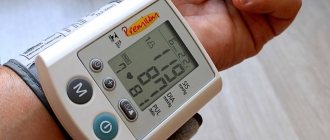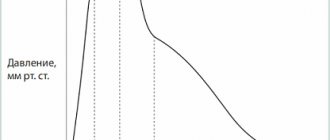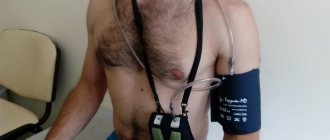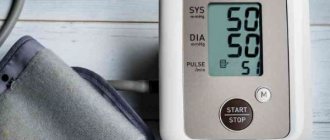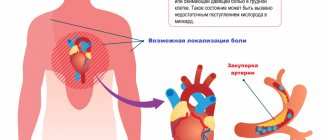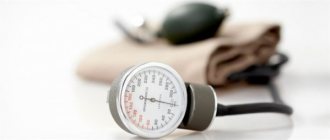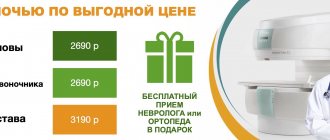Diastolic and systolic blood pressure is closely related to a person’s health status, gender characteristics and age. Based on its numbers, one can judge the presence of certain pathologies in the cardiovascular system. The first indicator is systolic (SBP). It reflects the power of pushing blood into the systemic circulation when the myocardium contracts.
Diastolic numbers (DBP) indicate the blood volume entering the bloodstream during the period of relaxation of the heart muscle. Using the pulse, you can monitor your heart rate (HR). The methodology for measuring these indicators has a clear algorithm. Only if all the nuances are followed will the numbers be reliable.
Blood pressure garden and dad what is it
Our readers successfully use ReCardio to treat hypertension.
Seeing how popular this product is, we decided to bring it to your attention. Read more here... An important indicator of human health is normal blood pressure. Over time, the numbers change. And what was unacceptable for young people is the ultimate dream for older people.
Currently, generally accepted standards are used that apply to all ages. But there are also averaged optimal pressure values for each age group. Deviation from them is not always a pathology. Everyone can have their own norm.
Modern classification
There are three options for normal blood pressure in an adult:
- optimal – less than 120/80;
- normal – from 120/80 to 129/84;
- high normal – from 130/85 to 139/89 mm Hg. Art.
Everything that fits into these numbers is absolutely normal. Only the lower limit is not specified. Hypotension is a condition in which the blood pressure monitor produces values less than 90/60. That is why, depending on individual characteristics, everything above this limit is acceptable.
On this online calculator you can see blood pressure norms by age.
Pressure measurement must be carried out in compliance with certain rules:
- 30 minutes before the intended procedure, you should not play sports or experience other physical activity.
- To determine true rates, the study should not be performed under stress.
- For 30 minutes, do not smoke, do not consume food, alcohol, coffee.
- Do not talk during the measurement.
- Measurement results obtained on both hands should be evaluated. The highest indicator is taken as a basis. A difference of 10 mm Hg is allowed. Art.
Individual norm
The ideal pressure is one at which a person feels great, but at the same time it corresponds to the norm. Hereditary predisposition to hypertension or hypotension matters. Numbers may change during the day. At night they are lower than during the day. During wakefulness, blood pressure can increase with physical activity and stress. Trained people and professional athletes often show indicators below the age norm. Measurement results are affected by medications and the use of stimulants such as coffee and strong tea. Fluctuations within 15–25 mm Hg are acceptable. Art.
With age, indicators begin to gradually shift from optimal to normal, and then to normal high. This is due to the fact that certain changes occur in the cardiovascular system. One of these factors is an increase in the rigidity of the vascular wall due to age-related characteristics. So, people who have lived their whole lives with numbers of 90/60 may find that the tonometer begins to show 120/80. And that's okay. A person feels good, since the process of increasing pressure occurs unnoticed, and the body gradually adapts to such changes.
There is also the concept of working pressure. It may not correspond to the norm, but the person feels better than with the one that is considered optimal for him. This is relevant for older people suffering from arterial hypertension. The diagnosis of hypertension is established if blood pressure is 140/90 mm Hg. Art. and higher. Many older patients feel better with numbers of 150/80 than with lower values.
In such a situation, you should not achieve the recommended norm. With age, cerebral vascular atherosclerosis develops. Higher systemic pressure is required to ensure satisfactory blood flow. Otherwise, signs of ischemia appear: headaches, dizziness, possible nausea, etc.
Another situation is a young hypotensive person who has lived with the numbers 95/60 all his life. A sudden increase in pressure even to the “cosmic” 120/80 mm Hg. Art. may cause a deterioration in health, reminiscent of a hypertensive crisis.
White coat hypertension is possible. However, the doctor cannot determine the correct pressure, since it will be higher at the appointment. And at home normal indicators are recorded. Only regular monitoring at home will help you determine your individual norm.
Methods for determining the norm
Each person is individual. This is determined not only by age, but also by other parameters: height, weight, gender. That is why calculation formulas were created that take into account age and weight. They help determine what pressure will be optimal for a particular individual.
The Volynsky formula is suitable for this. Used in people aged 17–79 years. Systolic (SBP) and diastolic (DBP) pressure indicators are calculated separately.
SBP = 109 + (0.5 × number of years) + (0.1 × weight in kg)
DBP = 63 + (0.1 × years of life) + (0.15 × weight in kg)
There is another formula that is applicable for an adult 20–80 years old. Weight is not taken into account here:
SBP = 109 + (0.4 × age)
DBP = 67 + (0.3 × age)
Approximate calculations for those who don’t want to count:
| Age in years | SBP/DBP, mm Hg. Art. |
| 20 – 30 | 117/74 – 121/76 |
| 30 – 40 | 121/76 – 125/79 |
| 40 – 50 | 125/79 – 129/82 |
| 50 – 60 | 129/82 – 133/85 |
| 60 – 70 | 133/85 – 137/88 |
| 70 – 80 | 137/88 – 141/91 |
Another reference table can be used to determine the norm:
| Age in years | SBP/DBP in men, mm Hg. Art. | SBP/DBP in women, mm Hg. Art. |
| Up to 1 year | 96/66 | 95/65 |
| 1 – 10 | 103/69 | 103/70 |
| 10 – 20 | 123/76 | 116/72 |
| 20 – 30 | 126/79 | 120/75 |
| 30 – 40 | 129/81 | 127/80 |
| 40 – 50 | 135/83 | 137/84 |
| 50 – 60 | 142/85 | 144/85 |
| 60 – 70 | 145/82 | 159/85 |
| 70 – 80 | 147/82 | 157/83 |
| 80 – 90 | 145/78 | 150/79 |
The indicators here differ from what can be obtained using calculation formulas. Studying the numbers, you will notice that they become higher with age. In people under 40 years of age, rates are higher in men. After this milestone, the picture changes, and women’s blood pressure becomes higher. This is due to hormonal changes in the female body. The numbers for people over 50 are noteworthy. They are higher than those currently defined as normal.
Conclusion
When assessing the tonometer indicators, the doctor always focuses on the accepted classification, regardless of how old the person is. The same blood pressure norm should be taken into account during home monitoring. Only with such values does the body function fully, vital organs do not suffer, and the risk of cardiovascular complications is reduced.
The exception is for elderly people or those who have had a stroke. In this situation, it is better to keep the numbers no higher than 150/80 mmHg. Art. In other cases, any significant deviations from the standards should be a reason to consult a doctor. This may hide diseases that require treatment.
Concepts and measurement of blood pressure and pulse
Traditionally, a person’s normal blood pressure is 120 over 80. But one should not categorically judge the adequacy of these indicators, since the numbers are influenced by gender, age, anatomical and physiological characteristics. The same can be said about the pulse. Normal blood pressure can increase in the absence of disease.
This occurs under high physical and emotional stress, changes in climate and ambient temperature. These same features can be observed when trying to measure a normal pulse. Heart rate increases if the room temperature rises.
Blood pressure measurement
When the temperature drops, the opposite picture is observed with the pulse. Therefore, to determine pathology, it is necessary to regularly monitor systolic and diastolic pressure and heart rate. Then it becomes possible to calculate the average figures and establish the frequency of their changes. Doctors have developed the following algorithm for performing measurements:
- You need to sit on a chair next to the table on which there is a device for determining blood pressure and pulse - a tonometer. If the procedure was preceded by physical or emotional stress, you need to sit quietly for about 15 minutes so that all processes in the body return to normal.
- The hand on which measurements will be taken must be placed at the level of the heart. To do this, the forearm is placed on the table surface at an angle of 90 degrees. If necessary, add a pillow.
A cuff is placed on the arm. The wire coming from it should be located at the level of the elbow on the inner surface of the arm. At this point, the vessels come closest to the surface of the body, which provides more adequate measurement results.- Using a bulb, they begin to pump air into the cuff. It gradually swells. At the same time, they monitor the indicators on the device monitor. The systolic pressure figure on it when pumping air should not exceed 200 mm Hg.
- If the tonometer is electronic, a stethoscope is not needed. But if it is old, mechanical, the phonendoscope is used to simultaneously listen to the pulse. Its head is applied to the main vessels located on the arm on which measurements are taken. When the doctor begins to hear a pulse wave, they pay attention to the numbers on the monitor. This is the systolic indicator. When the pulse wave disappears, diastolic numbers are recorded.
- It is advisable to measure on both arms and legs. Comparison of these indicators helps to establish atherosclerotic vasoconstriction or severe anatomical defects. For example, with coarctation of the aorta, the pulse in the legs will be lower than in the arms.
Heart rate is measured at the wrist or carotid artery. To do this, place two fingers in a certain projection and count the heartbeat per minute. It is necessary to be able to differentiate the pulse in the patient’s hand from the patient’s own pulse wave in the fingertips.
ABPM indicators in practical and research cardiology.
Akselrod A.S., Head of the Department of Functional Diagnostics, Cardiology Clinic of the MMA named after. THEM. Sechenov
The physiological interpretation of most indicators of 24-hour blood pressure monitoring (ABPM) is still widely debated in the literature today. It is customary to divide ABPM indicators into standard and additional. As a rule, it is the standard indicators that are presented in most registrars, since the main practical conclusions necessary for the selection of antihypertensive therapy are based on them.
Standard ABPM indicators
Standard indicators of ABPM include the following:
- average values of systolic (SBP), diastolic (DBP), average and pulse (PAP) blood pressure, as well as average heart rate for 24 hours, day and night;
- hourly average blood pressure and heart rate values;
- maximum and minimum values of blood pressure and heart rate for different periods of the day;
- daily index (degree of decrease in systolic and diastolic blood pressure at night);
- “pressure load” indicators: hypertension time index (TI), measurement index, hypertension area index (AI);
- variability of systolic, diastolic, mean and pulse blood pressure and heart rate.
Standard ABPM indicators are calculated automatically by the software and, most often, provided to the user in the form of a table (Figure 1).
Rice.
1. Standard indicators of ABPM: average values of systolic (SBP), diastolic (DBP), average and pulse (PBP) blood pressure, average heart rate per day, day and night; maximum and minimum values of blood pressure and heart rate for different periods of the day; daily index (degree of decrease in systolic and diastolic blood pressure at night, “day-night difference”).
Average values of systolic, diastolic, average and pulse blood pressure, average heart rate
per day, day and night.
Average blood pressure values
during the day, night and daytime (Figure 1) are presented in all recorders. The blood pressure level reflects the value of peripheral resistance.
In most cases, arithmetic mean blood pressure values are used as average values. The use of the median and mode is currently not widespread due to the overestimation of true blood pressure values. In accordance with the recommendations of the European Society of Hypertension, the normal level of daytime blood pressure should not exceed 135/83 mm Hg. Art., night – 120/70 mm Hg. Art. Blood pressure above 140/90 mmHg is considered elevated. and 125/75 mm Hg. during the day and night, respectively.
Pulse blood pressure
(Figure 1) characterizes the dynamic component of the pressor effect on target organs, and is also an indirect indicator of increased rigidity of large arterial vessels. High pulse pressure (PP) is an independent risk factor for coronary atherosclerosis and left ventricular hypertrophy. Due to the large number of publications on the possibility of using average PP as an independent predictor of coronary complications, many manufacturing companies have included this indicator in the list of standard ABPM indicators. In the absence of automatic calculation of PP in the software, this indicator can be easily calculated as the difference between the average values of SBP and DBP for the studied period of time.
Determination of average heart rate
during the day, daytime and nighttime are traditionally included in the list of standard ABPM indicators (Figure 1). It has been proven that people with tachycardia are predisposed to further development of atherosclerosis and hypertension. That is why a number of large international studies (Framingham, NHANES) have proven a connection between heart rate and cardiovascular mortality (including the risk of sudden death) in all age groups. Currently, the upper normal limit of average heart rate is considered to be 85 beats/min.
Maximum and minimum values of blood pressure and heart rate during the day
(Figure 1), as well as
hourly average values of blood pressure and heart rate
(Figure 2) allow us to study in more detail the features of the circadian rhythm of blood pressure and, accordingly, select the most optimal antihypertensive therapy.
Fig.2. Hourly average blood pressure and heart rate values.
Circadian rhythm of blood pressure and circadian index.
Assessing the characteristics of the circadian rhythm of blood pressure is absolutely necessary to decide on the need to prescribe and correct therapy. Therefore, it is of undoubted interest to assess the differences between the values of average daytime and nighttime blood pressure, i.e. severity of biphasic blood pressure rhythm. A healthy person should have a decrease in systolic and diastolic blood pressure at night by 10-20%. The simplest and most widely used method in clinical practice for assessing the circadian rhythm of blood pressure is to calculate the degree of nocturnal decrease in blood pressure - the diurnal index (CI).
The daily index is calculated using the following formula:
SI=100%x (ADd-ADn)/ADd, where ADD is the average BP during the waking period, BPn is the average BP during the sleep period.
Depending on the value of SI, 4 types of daily blood pressure curves are distinguished (Table 1). Table 1. Types of daily blood pressure curves
Age indicators for children
There is an increase in systolic and diastolic blood pressure depending on age. In children during the newborn period, the maximum values for systole reach 96, and for diastole - 50 mm Hg. Such low pressure is due to the fact that the circulatory system of a small child has not had time to acquire the anatomical features that are characteristic of adults. In babies, there is a duct of Botallus, which closes in the first year of life.
The discharge of blood into it lowers blood pressure in the great vessels. Also, the arteries and veins of children are more elastic. Reduced resistance contributes to a decrease in SBP and DBP. The heart does not need to supply blood to a huge area of the body. Therefore, the heart rate is much lower than in adults.
Table 3 - Comparison
| Age, years | Maximum blood pressure | Minimum blood pressure | Pulse limits, beats/min |
| Newborns | 96/50 | 60/40 | 120—140 |
| 6 months | 112/74 | 80/40 | 130—135 |
| 1 | 112/74 | 90/50 | 120—125 |
| 2 | 112/74 | 100/60 | 110—115 |
| 3 | 112/74 | 100/60 | 105—110 |
| 4 | 116/76 | 100/60 | 100—105 |
| 5 | 116/76 | 100/60 | 98—100 |
| 6 | 122/78 | 100/60 | 90—95 |
| 7 | 122/78 | 100/60 | 85—90 |
| 8—9 | 122/78 | 100/60 | 80—85 |
| 10 | 115/65 | 110/65 | 78—85 |
| 11 | 115/65 | 110/65 | 78—84 |
| 12 | 120/70 | 115/65 | 75—82 |
| 13—15 | 120/70 | 115/65 | 70—76 |
Blood pressure: deviations from the norm, measurement methods, treatment and prevention of diseases
Blood pressure has such a huge impact on our health and well-being that it is important to monitor it, especially in adulthood.
Blood pressure is one of the main indicators of the body’s condition, and its measurement is a mandatory part of a comprehensive health examination. Even a slight deviation from the norm can be risky. It should be noted that problems with blood pressure occur at different ages, both in elderly and very young people.
Treatment methods
Treatment is carried out not by the pathologically altered pulse pressure itself, but by the root causes that caused it, and only the general practitioner together with a cardiologist should determine the tactics of managing the patient, and only (!) after a thorough examination of the patient. It is very important to adhere to a number of mandatory conditions for the treatment of hypertension of this kind.
The pressure should never be reduced sharply. Its upper numbers should fall only gradually so that the vessels “have time to adapt” to their new indicators. Otherwise, the patient is at high risk of developing cardiovascular accidents.
You need to start therapy with small doses of drugs, gradually increasing the dosage.
The effect of the prescribed medications should not negatively affect the kidneys and cerebral (cerebral) circulation, which already suffer in older people.
For treatment carried out to equalize the difference, the following groups of drugs are used:
- Antihypertensive drugs are actually drugs against blood pressure, the main pharmacological group in this case. The primary use of one or more medications from the following pharmaceutical groups is indicated: calcium antagonists, beta-blockers, inhibitors of the renin-angiotensin-aldosterone system, and angiotensin receptor blockers. The dosage is usually selected empirically by the attending physician.
- Diuretic drugs - diuretics. A decrease in blood volume is indicated only if the difference between the indicators is caused by an increased SBP.
- Drugs that improve cerebral, renal or cardiac blood flow. In this case, they act as protectors, protecting these organs from the harmful effects of pathologically altered blood pressure numbers.
- Neuro- and cerebroprotectors are drugs that significantly improve the nutrition of nervous tissues and the brain. Indicated for the prevention of cardiovascular accidents.
In order to obtain the maximum effect, you can use combinations of drugs, and sometimes even radically change drugs and their variations, but only under the close supervision of a doctor. There is no single, fixed algorithm for management tactics in this state. The main treatment consists of correcting the patient’s lifestyle - only thanks to it, physical activity and proper nutrition can correct the state of metabolic processes.
Remember - self-medication is not allowed a priori, since taking antihypertensive drugs often affects both upper and lower blood pressure simultaneously.
The big difference may be a consequence of removal of the thyroid gland. In this case, a violation of pulse pressure is not a complication, but a completely natural phenomenon, and this indicator can be leveled to physiological values only with the help of replacement therapy (that is, ready-made hormones produced by this organ are taken).
A pathological gap in the values of SBP and DBP in the situation under consideration will lead to a lowered pulse, which in turn will affect SBP (it will sharply decrease), and the diastolic pressure will remain normal (this will mean that the value of OPSS remains unchanged).
It is clear that in order to normalize PD, you will most likely have to take all of the drugs listed above (except for antihypertensives and diuretics), however, the most important therapeutic element in the situation under consideration will be replacement therapy.
Heart health indicator
The heart muscle constantly pumps blood into the veins and arteries. Passing through them, blood puts pressure on the walls of blood vessels. Thus, blood pressure depends on the work of the heart and the elasticity of the blood vessels.
Pressure is not a constant value; it fluctuates depending on heartbeat cycles. The heart muscle contracts and relaxes approximately 60-80 times per minute. Systolic blood pressure is the maximum pressure recorded at the moment of heart contraction. In the interval between two contractions, when the heart relaxes, the pressure naturally decreases. The minimum pressure is called diastolic.
Blood pressure is measured in millimeters of mercury (mmHg). Systolic blood pressure is always listed first, and diastolic blood pressure is always listed second. Normal blood pressure is in the range of 110/70-130/85.
In addition to problems with the heart and blood vessels, blood pressure is influenced by a variety of factors - for example, physical activity, stress and addiction to tea and coffee increase blood pressure, and in weather-sensitive people it can fluctuate due to weather changes.
High blood pressure
Blood pressure 135/85-139/89 is considered elevated. If this figure reaches 140/90, then we can already talk about hypertension.
High blood pressure is a very dangerous condition. As is known, an increase in pressure for every 10 mm Hg. Art. increases the risk of developing cardiovascular diseases by a third. People with high blood pressure are 7 times more likely to develop cerebrovascular accidents (stroke), 4 times more likely to develop coronary heart disease, and 2 times more likely to develop vascular damage to the legs. In addition, hypertension can lead to poor vision and adversely affect kidney function.
Normal values in adults
SBP and DBP are closely related to age indicators. There is also a norm for heart rate according to age. It can reach several tens of units. The difference between the numbers is due to the fact that with age, the walls of blood vessels become sclerotic, thicken, and become less resilient and elastic.
At the same time, resistance to blood pressure increases. The same applies to the pulse. Even if older people do not have underlying cardiovascular or metabolic diseases, their heart rate is higher due to natural changes in myocardial physiology. Normal numbers are shown in Table 1 below.
Table 1 - Blood pressure and heart rate norms for adults
| Age, years | Indicators, mm Hg. Art. | Heart rate, beats/min | |||||
| Lower limit of SBP | Upper limit of SBP | Danger zone GARDEN | Lower limit of DBP | Upper limit of DBP | DBP danger zone | ||
| 15 | 80 | 120 | 120-129 | 50 | 80 | 80-89 | 60-70 |
| 16-29 | 90 | 130 | 130-139 | 60 | 85 | 85-90 | 60-70 |
| 30-39 | 90 | 130 | 130-139 | 60 | 90 | 90-94 | 60-80 |
| 40-59 | 90 | 140 | 140-149 | 60 | 90 | 90-94 | 65-85 |
| 60-69 | 100 | 150 | 150-159 | 60 | 90 | 90-94 | 70-90 |
Blood pressure (BP). How to measure blood pressure correctly?
It is known that the total amount of blood in the body is 6–8% of body weight. Using a simple calculation, you can easily find out the blood volume of each person. So, with a weight of 75 kilograms, the blood volume is 4.5 - 6 liters. And all of it is enclosed in a system of vessels communicating with each other. So, when the heart contracts, blood moves through the blood vessels, puts pressure on the wall of the arteries, and this pressure is called arterial pressure. Blood pressure helps move blood through the vessels.
